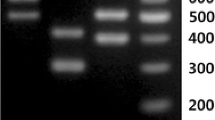Abstract
The effects of two crude bacteriocins (DF01 and K10) on lactic acid bacteria (LAB) communities and pH during kimchi fermentation were analyzed by polymerase chain reactiondenaturing gradient gel electrophoresis (PCR-DGGE). Crude LAB bacteriocins, prepared by ammonium sulfate precipitation, were added at 5 AU/mL, and kimchi was incubated at 20°C for 7 days. The pH and titratable acidity of the kimchies were determined daily, and the amplified 16S rRNA products were analyzed by PCR-DGGE. The common and main LAB were Weissella spp., Leuconostoc spp., and Lactobacillus spp. from both control and bacteriocin-treated samples. Among them, W. koreensis, W. confusa, and Lb. sakei were the predominant microorganisms throughout the fermentation period. Some obligate and facultatively heterofermentative LAB were detected from the bacteriocin-treated samples. The pH of the kimchi samples treated with each bacteriocin was higher (ca. 0.8 unit) than that of the control at day 4 and 5.
Similar content being viewed by others
References
Raymond J. World’s healthiest foods: Kimchi (Korea). Available from: http:// eating.health.com/tag/health-magazine-march-2006/ Accessed Apr. 21, 2015.
Jung JY, Lee SH, Jeon CO. Kimchi microflora: History, current status, and perspective for industrial kimchi production. Appl. Microbiol. Biot. 98: 2385–2393 (2014)
Cheigh HS, Park KY. Biochemical, microbiological and nutritional aspects of kimchi (Korean fermented vegetable products). Crit. Rev. Food Sci. 34: 175–203 (1994)
Kim WJ. Bacteriocins of lactic acid bacteria: Their potentials as a food biopreservative. Food Rev. Int. 9: 299–313 (1993)
Settanni L, Corsetti A. Application of bacteriocins in vegetable food biopreservation. Int. J. Food Microbiol. 121: 123–138 (2008)
Choi MH, Park YH. Selective control of lactobacilli in kimchi with nisin. Lett. Appl. Microbiol. 30: 173–177 (2006)
Ryu HJ, Chung CH, Kyung KH. Evaluation of nisin as a preservative to prevent over-acidification of kimchi. Food Sci. Biotechnol. 7: 205–208 (1998)
Moon GS, Kang CH, Pyun YR, Kim WJ. Isolation, identification, and characterization of a bacteriocin-producing Enterococcus sp. from kimchi and its application to kimchi fermentation. J. Microbiol. Biotechn. 14: 924–931 (2004)
Chang JY, Chang HC. Improvements in the quality and shelf life of kimchi by fermentation with the induced bacteriocin producing strain, Leuconostoc citreum GJ7 as a starter. J. Food Sci. 75: 103–110 (2010)
Water J, Tannock GW, Tilsada-Timisjarvi A, Rodtong S, Loach DM, Munro K, Alatossava T. Detection and identification of gastrointestinal Lactobacillus species by using denaturing gradient gel electrophoresis and species specific PCR primer. Appl. Environ. Microb. 66: 297–303 (2000)
Ahmadsah LSF, Min SG, Han SK, Hong Y, Kim HY. Effect of low salt concentration on microbial changes during kimchi fermentation monitored by PCR-DGGE and their sensory acceptance. J. Microbiol. Biotechn. 25: 2049–2057 (2015)
Hong Y, Yang HS, Chang HC, Kim HY. Comparison of bacterial community changes in fermenting kimchi at two different temperatures using a denaturing gradient gel electrophoresis analysis. J. Microbiol. Biotechn. 23: 76–84 (2013)
Lee JS, Heo GY, Lee JW, Oh YJ, Park JA, Park YH, Pyun YR, Ahn JS. Analysis of kimchi microflora using denaturing gradient gel electrophoresis. Int. J. Food Microbiol. 102: 143–150 (2005)
Kang TK, Kim WJ. Characterization of an amylase-sensitive bacteriocin DF01 produced by Lactobacillus brevis DF01 isolated from dongchimi, Korean fermented vegetable. Korean J. Food Sci. An. 30: 795–803 (2010)
Kwon DY, Koo MS, Ryoo CR, Kang CH, Min KH, Kim WJ. Bacteriocin produced by Pediococcus sp. in kimchi and its characteristics. J. Microbiol. Biotechn. 12: 96–105 (2002)
Moon GS, Kim WJ, Kim MH. Synergistic effects of bacteriocin-producing Pediococcus acidilactici K10 and organic acids on inhibiting Escherichia coli O157: H7 and applications in ground beef. J. Microbiol. Biotechn. 12: 936–942 (2002)
Lee YM, Kim JS, Kim WJ. Optimization for the maximum bacteriocin production of Lactobacillus brevis DF01 using response surface methodology. Food Sci. Biotechnol. 21: 653–659 (2012)
Yeates C, Gillings MR, Davison AD, Altavilla N, Veal DA. Methods for microbial DNA extraction from soil for PCR amplification. Biol. Proced. Online 1: 40–47 (1998)
Yoo KS. Lactic acid bacteria diversity in makgeolli and its effects on fermentation process and quality. PhD thesis, Chung-buk National University, Daejeon, Korea (2013)
Altschul SF, Madden TL, Schäffer AA, Zhang J, Zhang Z, Miller W, Lipman DJ. Gapped BLAST and PSI-BLAST: A new generation of protein database search programs. Nucleic Acids Res. 25: 3389–3402 (1997)
Lee CW, Ko CY, Ha DM. Microfloral changes of the lactic acid bacteria during kimchi fermentation and identification of the isolates. Microbiol. Biotechnol. Lett. 20: 102–109 (1992)
Lim CR, Park HK, Han HU. Reevaluation of isolation and identification of Grampositive bacteria in kimchi. Microbiol. Biotechnol. Lett. 27: 404–414 (1989)
Mheen TI, Kwon TW. Effect of temperature and salt concentration on kimchi fermentation. Korean J. Food Sci. Technol. 16: 443–449 (1984)
Cho J, Lee D, Yang C, Jeon J, Kim J, Han H. Microbial population dynamics of kimchi, a fermented cabbage product. FEMS Microbiol. Lett. 257: 262–267 (2006)
Choi HJ, Cheigh CI, Kim SB, Lee JC, Lee DW, Choi SW, Park JM, Pyun YR. Weissella kimchii sp. nov., a novel lactic acid bacterium from kimchi. Int. J. Syst. Evol. Micr. 52: 507–511 (2002)
Kim J, Chun J, Han H. Leuconostoc kimchii sp., nov., a new species from kimchi. Int. J. Syst. Evol. Micr. 50: 1915–1919 (2002)
Park SJ, Chang JH, Cha SK, Moon GS. Microbiological analysis of dongchimi, Korean watery radish kimchi, at the early and mid-phase fermentation. Food Sci. Biotechnol. 17: 892–894 (2008)
Tolonen M, Rajaniemi S, Pihlava JM, Johansson T, Saris PEJ, Ryhänen EL. Formation of nisin, plant-derived biomolecules and antimicrobial activity in starter culture fermentation of sauerkraut. Food Microbiol. 21: 167–179 (2004)
Author information
Authors and Affiliations
Corresponding author
Rights and permissions
About this article
Cite this article
Jeong, M., Kim, J., Choi, E. et al. PCR-DGGE analysis of population dynamics of lactic acid bacteria in kimchi by addition of bacteriocins. Food Sci Biotechnol 25, 1123–1128 (2016). https://doi.org/10.1007/s10068-016-0180-x
Received:
Revised:
Accepted:
Published:
Issue Date:
DOI: https://doi.org/10.1007/s10068-016-0180-x



